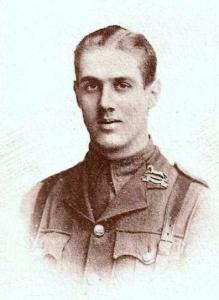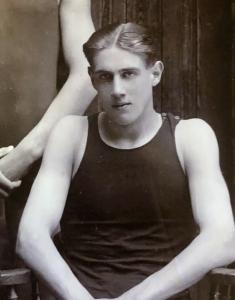
|

|
| Lieutenant Tom Elsworth ARMISTEAD MC | |
|
C Company, 2/6th Battalion (Prince of Wales’ Own) West Yorkshire Regiment Date of birth: 12th February 1895 Date of death: 3rd May 1917 Killed in action aged 22 Commemorated on the Arras Memorial Bay 4 |

|
| Tom Elsworth Armistead was born at "Ferndale", Bingley in Yorkshire on the 12th of February 1895 the third and youngest son of Richard Armistead, a civil engineer, architect and surveyor, and Sarah "Sally" Ann Eliza Townsend (nee Walker) Armistead of Wells House, Ilkley in Yorkshire, later of 10 Booth Street, Bradford. He was christened at All Saints Church, Bingley on the 10th of April 1895. He was educated at the Grammar School at Ripon and at Lancing College where he was in News House from January 1909 and in Olds House from September 1910 to July 1913. He was a Sergeant in the Officer Training Corps, was in the Football XI in 1911/12 and was appointed as a House Captain in 1912. He was a member of the Swimming Team in 1913 and was appointed as a Prefect the same year. He later played rugby for Ilkley Rugby Football Club. He was commissioned as a 2nd Lieutenant in the West Yorkshire Regiment on the 10th of September 1914 and embarked for France with the 1/6th Battalion of his regiment from Folkestone on board the SS "Victoria at 9.30pm on the 15th of April 1915 and arrived at Boulogne at 10.45pm. He was promoted to Temporary Captain while in charge of a Company on the 1st of August 1916 and relinquished his rank on the 30th of October 1916 when he received a change of posting. He was evacuated to England suffering from synovitis of the knee on the 22nd of October 1916. He was awarded the Military Cross in the King’s New Years Honour List of the 1st of January 1917. He returned to France in February 1917 where he was attached to the 2/6th Battalion of his regiment and was promoted to Lieutenant after his death on the 10th of July 1917. At 2.10 am on the morning of the 3rd of May 1917 the men of the 2/6th Battalion West Yorkshire Regiment met the guides who were to lead them into the front line trenches for an attack later that morning. Their task, in conjunction with other battalions from their Brigade, was the attack on a section of the Hindenburg Line including the capture of the village of Bullecourt, the capture of Hendecourt and the formation of a defensive flank from Hendecourt to the Hindenburg Line. The 2/6th West Yorks were tasked with entering the German front line and bombing eastwards to link up with the Australians who would be working down the trench from their left. During this period the British artillery would cease fire for 27 minutes to enable the two attacking groups to complete their tasks. They informed Brigade that they were in position at 3.10 am. At 3.30 am the German artillery put down a heavy barrage across no man's land which gradually spread down the line and at 3.45am the British artillery commenced their bombardment of the line to be attacked with the troops moving forward at the same time. The West Yorks advanced in four waves but soon lost direction due to the smoke from the barrage and were hampered by the hail of rifle and machine gun bullets which were sweeping no man's land. On the right of the attack, A Company attempted to correct their direction but very few of them made the enemy wire and those that that managed to get into the trench were killed or captured by a German counterattack. B Company suffered a similar fate, most being killed, wounded or captured. As a result no link with the Australians was possible. C Company under Tom Armistead, on the left of the attack, was more successful and occupied a trench in front of Bullecourt but they were counterattacked, ran out of bombs, and were forced to withdraw. D Company managed to get as far as the village church but as their path of retreat was cut off, little information is known as to their fate. At the end of the attack the roughly 100 survivors of the battalion fell back to their original positions. The survivors were relieved at 9pm by the Honourable Artillery Company and marched back to caves at Ecoust St Mein. Tom Armistead was reported as missing during the attack. His father wrote to the War Office in a letter dated the 15th of February 1918: - "Sir, I have your letter of the 10th instant to the effect that no further report has been received concerning 2nd Lieutenant T.E. Armistead, 6th Battalion, West Yorkshire Regiment, reported missing 3rd May 1917. The best information I have been able to get is that Lieut. Armistead was in Command of C Company and that he led his men through the barbed wire on the east side of Bullecourt when he discovered a German machine gun enfilading the trench they were to occupy. He called for 3 bombers, Bannister, Brook and Drew and went over with them only. They put the machine gun out of action and he rushed the position, armed with his revolver only, and was shot at close range by a German rifle and was seen to fall. his men dropped into a shell hole and later retired, except Bannister who was also shot. This information is given by Brook. 2nd Lieutenant Armistead went to France in April 1915 with the 1/6th West Yorks and was fighting with them until October 1916 when he was invalided home with synovitis of the knee. He had been Acting Captain for some time and won the Military Cross. He returned to the front as Acting Captain in February 1917 and was posted to the 2/6th West Yorks who had gone out the month before, and I believe was the only officer in the battalion who had seen any fighting. he was a fine specimen of humanity and acknowledged by both officers and men of the first and second sixth West Yorks to be a first rate officer. Yet on joining the 2/6 he had to take off two stars and to come down to 2nd Lieutenant, after fighting for two years. And although he was in command of a Company on the 3rd May he was posted missing as a 2nd Lieutenant. Since that date he has been gazetted as a Lieutenant. I know he felt this keenly, and I cannot help thinking that he has been badly treated, and I do not think this is through any fault of his commanding officers. I shall be obliged if you can tell me to whom to apply for the Military Cross which was granted to him when he was with the 1/6th West Yorks. I am, Sir, Your truly R. Armistead. He wrote to the War Office once again in a letter dated the 28th of November 1918: - "Sir, I am in receipt of your letter of the 23rd instant. Lieutenant T.E. Armistead, 6th Battalion, The West Yorkshire regiment, went to France with the 1/6th Battalion of the West Yorks in April 1915. he was fighting with this Battalion until October 22nd 1916 when he was invalided home with synovitis of the knee. For a considerable part of this time he was "Acting Captain" and was given the M.C. He returned to France early in February 1917, and I believe he had the badges of Acting Captain on his uniform when he returned. But if he had reverted to 2nd Lieutenant during the three months he was away from his regiment, he would have been sure to get his Acting Captaincy on return to his own regiment, as on his seniority he would have been given a Company. He was posted to the 2/6 which had just gone out, where there were several senior to him who had never seen active service. he had however to take off his Acting Captain's badges and this broke him up. In the Bullecourt show he was not "Acting Captain, he was only Acting Company Commander for someone else, and so went out of this life as a 2nd Lieutenant after fighting for over two years. I know that promotion in the T.F. units has been altered since, but this does not help me to forget that a young life, a magnificent specimen of humanity and one who really did not know what fear was, should have given his young life to his Country and should have been so grossly unfairly treated." I am, Sir, Yours Truly R. Armistead Probate was granted at a hearing in Wakefield on the 9th of October 1919 and he left £1,409 to his mother in his will. The screen which forms the entrance to the war memorial cloister at Lancing College was given in his memory by his two brothers, Colonel Richard Burnie Armistead MC, 6th Battalion West Yorkshire Regiment and Captain James Henry Armistead OL (Heads House 1908-1911), 5th Battalion West Yorkshire Regiment. |
|
 | |
| Olds House |
Back